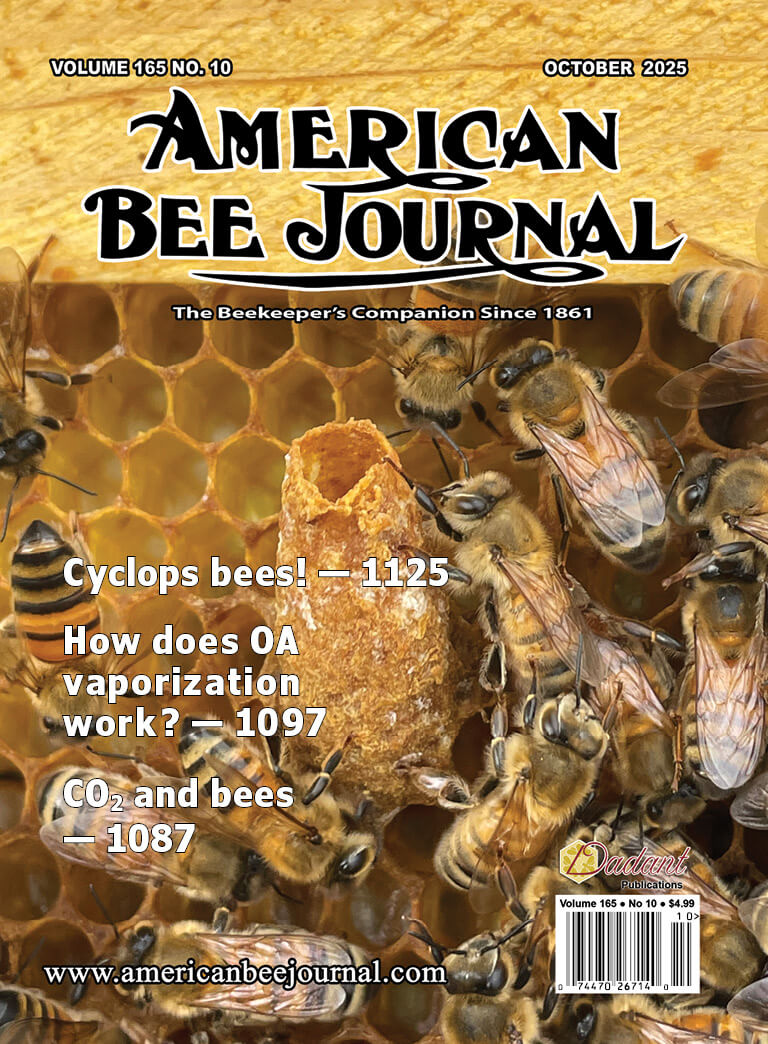
I just returned from the annual American Beekeeping Federation conference in Jacksonville, Florida. It was an exceptionally well-run meeting. In my opinion, what stood out the most was the interest that people had in non-synthetic chemical controls against varroa and other parasites and diseases.
I was asked about phytochemical therapeutics (i.e., plant-derived medicines against troublesome parasites such as varroa and nosema) after my talk, similar questions were asked after a talk by USDA Beltsville Bee Lab scientist Jay Evans, and numerous people came up to me in the hallways to ask additional follow-up questions and chat about the topic.
Some phytochemical therapeutics already exist on the market. For example, two popular varroacide products are Apiguard (active ingredient: thymol) and HopGuard III (active ingredient: hop beta acids). Thymol is familiar to anyone who roasted a turkey for Thanksgiving; it’s the main phytochemical in the thyme on your spice shelf. And hop beta acids are familiar to anyone who had a beer with that turkey; they’re the reason that beer had a somewhat bitter flavor, from the hops used during brewing.
Honey bee research continues to prospect for new phytochemicals that may have therapeutic abilities. At the same time, a separate but parallel line of research is investigating how certain pollen diets impact bees, potentially in therapeutic ways. One of these pollens is sunflower, which happens to be my favorite plant in my garden. Is there evidence that bees consuming sunflower pollen have reduced levels of parasites and pathogens including varroa, nosema, and viruses? And is there evidence that more sunflower in a landscape corresponds to reduced levels of varroa and nosema? These are the topics for the sixty-second Notes from the Lab, where I summarize “Sunflower-associated reductions in varroa mite infestation of honey bee colonies,” written by Evan Palmer-Young & colleagues and published in the Journal of Economic Entomology [2022].
For their study, Palmer-Young and colleagues combined an observational survey and three manipulative experiments. The observational survey made use of the impressive USDA-APHIS National Honey Bee Disease Survey, which assesses varroa and nosema levels in colonies of >400 apiaries in >30 U.S. states each year. To evaluate associations between sunflower crop area and varroa/nosema levels in colonies, the authors limited their analysis to states with apiaries within a 3.2 km radius of a sunflower crop (i.e., a reasonable flight radius for honey bee foragers), as determined by the National Agricultural Statistics Service cropland data layer. They included observations of varroa and nosema that were made in August and September, corresponding to bloom time for sunflower. This included 181 colony observations from five states: South Dakota, North Dakota, New York, Georgia, and Wisconsin.
The authors also conducted three sunflower feeding experiments. First, they teamed up with a commercial beekeeper in Massachusetts in the spring of 2018 and supplemented colonies for five weeks (May 23 – June 27) with 170 g patties containing one of four pollen treatments: sunflower, wildflower, sunflower-wildflower mix, or artificial pollen (BeePro). A fifth treatment group received no supplementation. Varroa and nosema levels were measured pre- and post-treatment.
A similar colony feeding experiment was conducted in late summer (September 4 – October 9) at a University of Maryland apiary by supplementing with 900 g patties containing sunflower, wildflower, or artificial pollen (BeePro). Varroa, nosema, and seven viruses (Acute Bee Paralysis Virus [ABPV], Chronic Bee Paralysis Virus [CBPV], Deformed Wing Virus [genotype ‘A’, hereafter referred to simply as DWV], Israeli Acute Paralysis Virus [IAPV], Kashmir Bee Virus [KBV], Lake Sinai Virus-2 [LSBV-2], and Varroa destructor Virus-1 [VDV-1, synonymous with ‘DWV-B’]) were measured pre- and post-treatment.
Finally, the authors also conducted a feeding experiment in the lab with small cohorts of caged adult bees (30 workers per cage). Bees fed on one of four treatments (sunflower pollen mixed with wildflower pollen in ratios of 3:0, 2:1, 1:2, and 0:3) or a no-pollen control for six days. Nosema and virus (DWV and VDV-1) levels were assessed post-treatment. Palmer-Young and USDA colleagues will conduct more extensive controlled experiments with bees, mites, and sunflowers this year, with support by Project Apis m.
So, what did they find? Was there an association between sunflower crop area and nosema or varroa in colonies? No and yes. There was no relationship between sunflower crop area and nosema levels in colonies. But there was a highly significant negative relationship between sunflower crop area and varroa levels in colonies. For each doubling of sunflower crop area there was a 28% reduction in varroa levels. In other words, when more sunflower was grown within the flight radius of an apiary, the colonies in that apiary had lower varroa levels. Very interesting.
Was varroa reduced in colonies when they were supplemented with sunflower pollen? Yes. As seen in Figure 1, there was a 2.75-fold reduction in varroa levels when colonies were supplemented for five weeks with sunflower pollen versus BeePro artificial pollen. Wildflower pollen supplementation resulted in intermediate varroa levels. No differences in virus or nosema levels were observed among treatments. Similarly, there were no differences in nosema or virus levels among treatments in the lab cage study.
Okay, the field survey and apiary pollen supplementation results with respect to varroa and sunflower seem very promising. What might be going on? This study was not designed to tease out the mechanism(s) underlying sunflower-mediated reductions in varroa infestations. But that doesn’t mean we can’t speculate. Indeed, speculation may be useful for designing follow-up studies that better tease out the mechanism(s) and, ultimately, perhaps could lead to new varroacidal therapeutics.
If consuming sunflower pollen is conferring anti-varroa benefits to bees, those benefits could be coming in the form of phytochemicals, nutrients, and/or other attributes of sunflower pollen. On the phytochemical side of things, one recent study found ….


